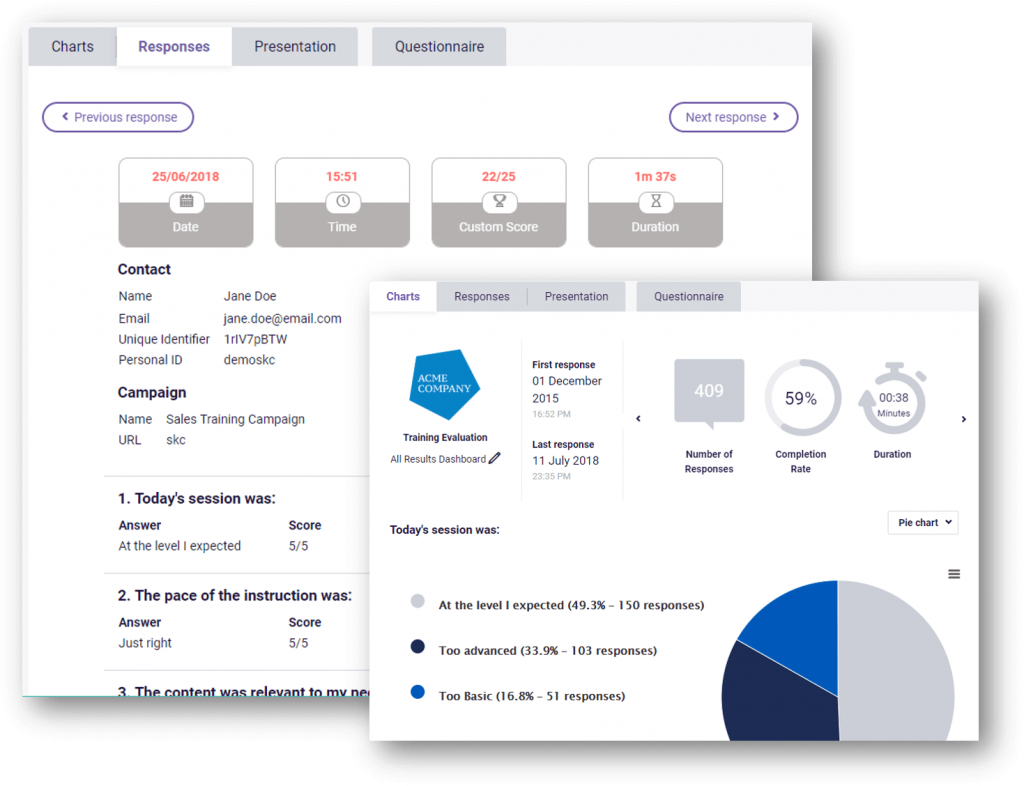Have you ever walked out of a classroom and thought “What did we actually learn in class just now?” and just couldn’t remember? Nothing is more frustrating or tiresome than attending a training that isn’t relevant, interesting OR effective.
Now turn that scenario around, if you’re a company investing in employee training or you’re the educator standing in front of a classroom, you’d want to know your course was relevant. Right?
That’s where training evaluations should come into play!
Why training evaluations are so useful
Evaluations are an essential part of any training tool. But there’s more to them than just “getting feedback about the course”. By asking the right kinds of questions, or taking the evaluation in the shape of an interactive quiz or assessment, they can:
- Improve knowledge retention for employees or students
By quizzing students on a regular basis about what they learned during the course, you stimulate them to rehearse the course materials and help them think about applying that knowledge on a day-to-day basis. - Check whether candidates are able to implement what they’ve learned
Especially on the work floor a quiz or assessment with work-related statements can stimulate employees to apply the things they’ve learned and see them in the right context. Their scores at the end of the training evaluation work as a motivator to do even better and perhaps compete with team members. - Ensure the quality of training by evaluating the trainers and course materials
In combination with testing the effectiveness of a learning course, you should allow participants to voice their feedback. To help finetune the teaching method, course materials and trainers’ approach. It helps to keep this separate from the previously mentioned quizzes, feedback is more willingly given in an anonymous environment. - Increase attendee satisfaction and productivity
By continuously optimizing your training and by being open-minded towards feedback from attendees you’ll see attendee satisfaction increase almost immediately. Next to that, stimulating knowledge retention through quizzes will result in higher productivity as well. As you’re teaching your employees or students to apply their knowledge in the long run.
The right moment to plan a training evaluation
Should you finish your training session with an evaluation? Or is it best to let the course sink in for a bit before you send out your survey or interactive quiz?
According to Art Kohn, you’ll have to be fast!
Did you know that after 24 hours an average of 70% of freshly gained information is forgotten?
The easiest approach is usually to send all attendees a personal email message that invites them to fill out a survey or assessment right after the course. Our recommendation here is to have participants take your training evaluation within 24 hours of the course. It ensures the information is still on their mind and will provide you with more accurate, in-the-moment feedback.

What you should do with results after testing
And then the hard work begins!
Measuring the results of your training efforts can be very time-consuming. Especially in trying to identify the outcomes, benefits or final results that can be linked to the training.
The short-term value of analysis is that you can improve your future training sessions based on the feedback. Offer your respondents enough opportunities to voice their opinions in an open way.
And for the long-term, it’s important to keep in mind the goals you wished to reach with your training and see how you can link back to it in your training evaluation survey or assessment. Goals you could consider (depending on your training objectives) can vary from increased employee retention to an increase in productivity, higher morale, increased sales, increased customer satisfaction, …
How can you get better insights from using a survey during evaluations?
There are a couple of great benefits attached to doing a “formal” evaluation of your training through testing with an exam maker or by conducting a regular survey.
If you want to make sure that you’ll get spontaneous input in your survey the way you’d get by simply asking a question at the end of class, make sure you send out your quiz or survey as soon as possible after the course is finished.
Some benefits are:
- Detailed reporting – Clear data on each and every participant is the perfect training tool. How well they did, where there’s room for growth and even overall insights that show you what parts of a training could use improvement based on general results, …

- Knowing exactly what information participants are struggling with – on an individual basis if you’re focusing on personal development or in general if you’re looking at results of the entire group. This data can help you create follow-up training or exams and point out where there’s room for growth. Both on the team and in the training program.
- Improve understanding of participants’ strengths and weaknesses to inform career opportunities moving forward – Especially the individual aspect of conducting a training evaluation survey can prove to be useful for employees, whether or not they can still grow in their current jobs or not and what their future direction could be. By regularly quizzing them through simple exam software you never lose sight of their progress.
4 aspects that make a great training evaluation
When you’re first starting out with your training course, or you wish to optimize what you’ve already got, keep these 4 tips in mind to boost your training evaluation.
- Effectiveness – This part of the evaluation focuses on the “what’s in it for me?” question. Was it answered by the course and was it sufficient/satisfactory for the participant.
- Comprehension – Ask questions about the way the course content was delivered.
- Attractiveness – Especially in digital learning environments it’s important to find out whether your interface, learning environment and resources are appealing and user-friendly.
- Engagement – Implement interactivity and quiz-elements into your evaluation to increase engagement of your attendees and to make the course content stick around longer.
A training evaluation offers tons of benefits, both in a business and school environment. Not only for students but for trainers and course materials as well. And today it’s incredibly easy to make training evaluations that are easy to take and easy to analyze.
Are you still on the fence about the effectiveness of training and training evaluations? Let’s debunk a couple of myths on the topic!
Professional training myths
What is the usual response when professional training is mentioned? Some slight acknowledgment? Possibly a room full of grimacing faces? We know, this reaction and preconceived connotation towards professional training have been plaguing industries for years.
Nearly 80% of learning and development professionals agreed that developing employees is a top priority for their organization’s executive team, but how many actually act on their sentiments of encouragement? Many times you will find a company that speaks out and says they promote employees taking further training, but only 27% of L&D teams received an increase in budget. So how do you as a professional who is advocating for more professional training in your organization tackle this misconception?
Professional training has transformed through the immense and rapid influence that the digital age has created – great news for any professional in both L&D and Human Resources. Now professional training has included a variety of learning methods, so as to accurately educate varying range learning styles. Professional training is no longer only beneficial for the organization as a whole but rather gives individual employees more skills and abilities to further develop themselves – a win-win for both the company and the individual. Learning cultures have proven to harness and encourage micro-learning as well, furthering the efforts of training professionals to levels that were once dormant.
Still not convinced? Findcourses.com has identified some of the most common training myths and debunked them all. Check out the following infographic loaded with data, research, and insights from LinkedIn Learning, ATD and more.

Source
Discover more about these training tools here or get started straight away by signing up to the Pointerpro survey maker. You’ll find an amazing training evaluation template already waiting for you in the tool!






